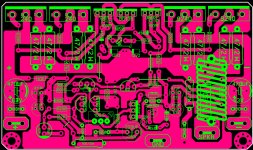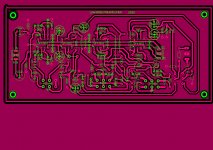Hi, i am new to the world of DIY amps. I want to build a DIY amp from one of Mr. Apex's design. I need an amp that is capable of 100w+ output per channel. I am currently torn between FX8 Bimo mod, FH9, and AX16. I can't seem to find the specs of those amps. Do anyone have a recommendation of which amp is better to build in general? Thanks
The FH9 is now available in a souped up 100+w version with super layout by JPS64 and fully supported in this thread:
FH9HVX - Budget Conscious 100w Class AB for Lean Times
It’s capable of 0.003% THD at 100w 8ohms according to sims. Only 1 pair of output FQA MOSFETs - +/-52v rails. Superb sounding. The original FH9 is also excellent but I think this one is easier to work with since roomier PCB and has optional flying leads for MOSFETs which makes installation a snap.
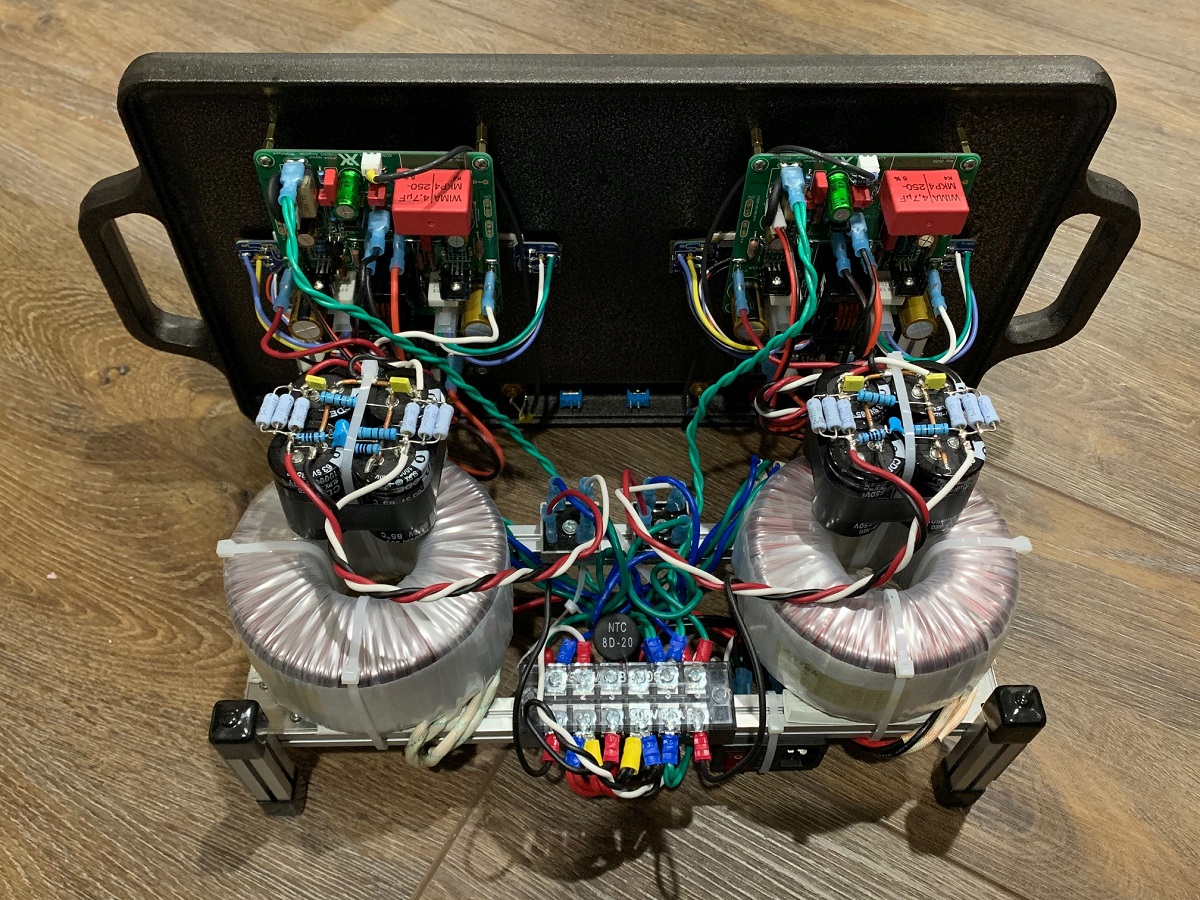
I also have the FX8 Bimo and like the FH9 better.
FH9HVX - Budget Conscious 100w Class AB for Lean Times
It’s capable of 0.003% THD at 100w 8ohms according to sims. Only 1 pair of output FQA MOSFETs - +/-52v rails. Superb sounding. The original FH9 is also excellent but I think this one is easier to work with since roomier PCB and has optional flying leads for MOSFETs which makes installation a snap.
I also have the FX8 Bimo and like the FH9 better.
Last edited:
Love your cast iron heat sink. With that kind of cost cutting, I almost expected to see re-wound re-purposed toroids being used to power it.....
The toroids were indeed repurposed from another project and happen to almost be the right voltage. The P2P PSU's were from another project also. The Griddle Amp is one of the most cost effective heatsinks I have found thus far. Surplus CPU coolers and a fan are almost as inexpensive but don't give you the "big iron" look.
Its rather had to get other pcb than the ones that are readily available in my country. Do you have other recomendation?
Search for the FH11 v1.07 by eaglemod, it’s a FH9 with 2 more outputs. I run it with +/-65V and get 165w into 8ohms. I would go with +/-50-55V if I did t already have the other xfrmr. Should get you 125w and handle 4-ohms much better. There are gerbers posted and can get 5 for $2 at jlcpcb. Best bang for buck I’ve found. PM me and I can send you the schematic, gerbers and might have the BOM too.
The FH11 is pretty good - I was trying to achieve almost that performance for just a pair of outputs on the FH9HVX. But I do recall many folks had a great success with the FH11.
https://www.diyaudio.com/forums/sol...imate-fidelity-amplifier-805.html#post4777079
This is the Sonal K version:
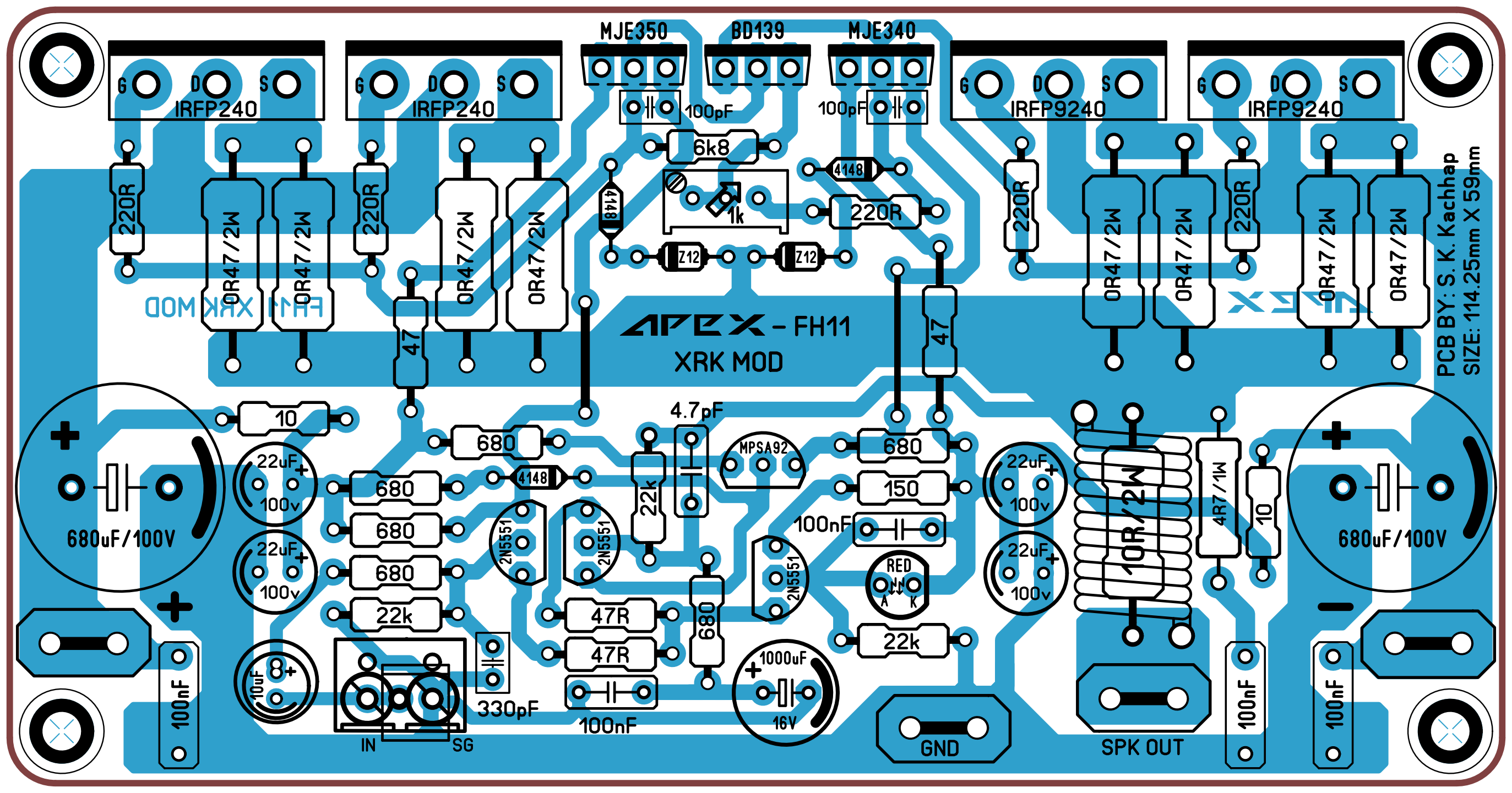
https://www.diyaudio.com/forums/sol...imate-fidelity-amplifier-805.html#post4777079
This is the Sonal K version:
Last edited:
FX11
1 input transistor pair 2sc1845 very low noise
2 100 ohm offset preset added
3 10 ohms 2 watt ground lift resistor
4 2 mpsa trs in series as adviced by Apex audio
KSA3503/1381 REALLY brighten up the sound highly recomended
trying to make a matching high quality low noise preamp with tone defeat
this is just a test pcb final pcb will be double sided with all smd
warm regards
Andrew😉😉😉
1 input transistor pair 2sc1845 very low noise
2 100 ohm offset preset added
3 10 ohms 2 watt ground lift resistor
4 2 mpsa trs in series as adviced by Apex audio
KSA3503/1381 REALLY brighten up the sound highly recomended
trying to make a matching high quality low noise preamp with tone defeat
this is just a test pcb final pcb will be double sided with all smd
warm regards
Andrew😉😉😉
Attachments
Hi Andrew,
The KSC1845 for the LTP and KSC3503 for the LTP CCS, and KSA1381 and kSC3503 drivers are used in the FH9HVX and I also believe, contributes to the amp’s superb performance, beating the previous version FH9, which used BC546 and BD140/139.
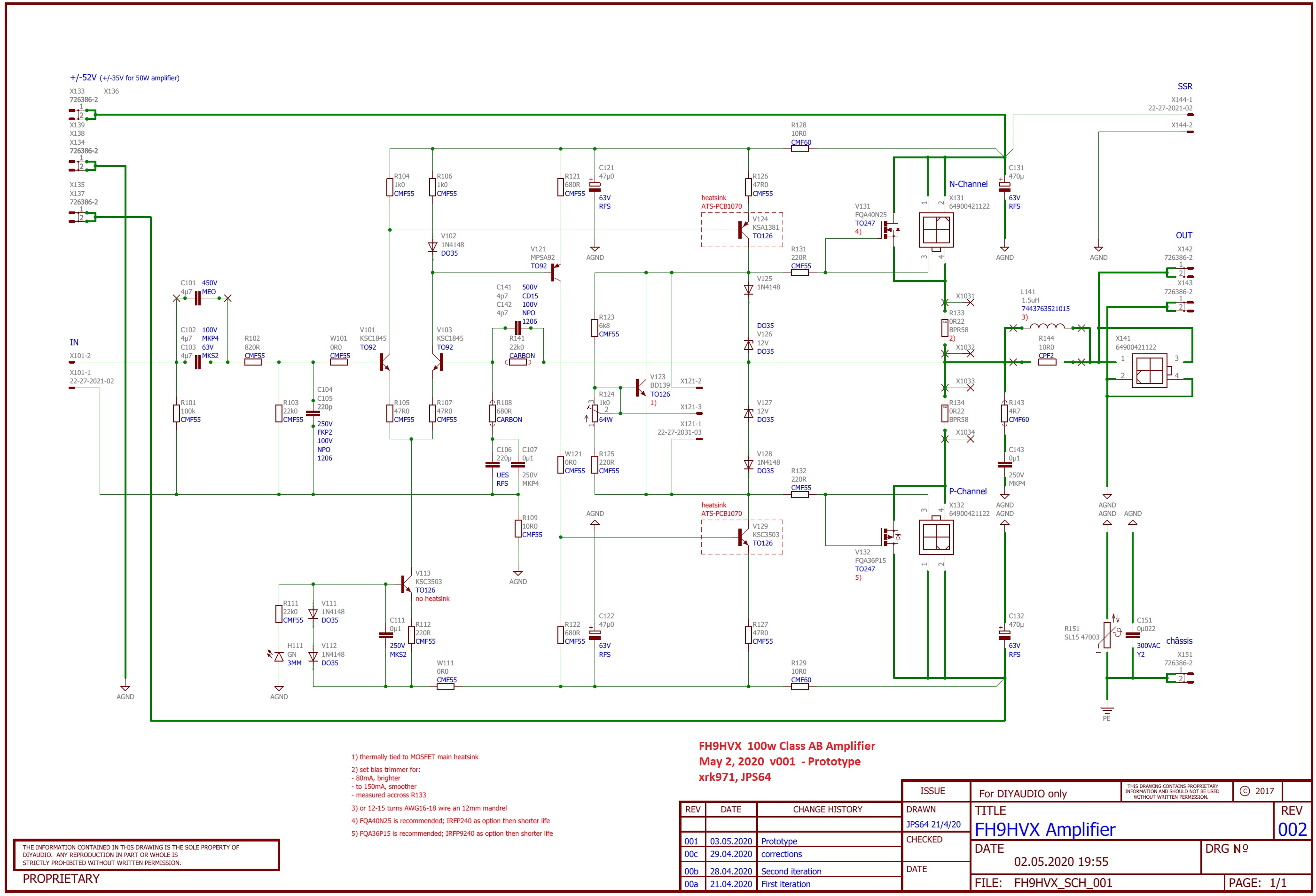
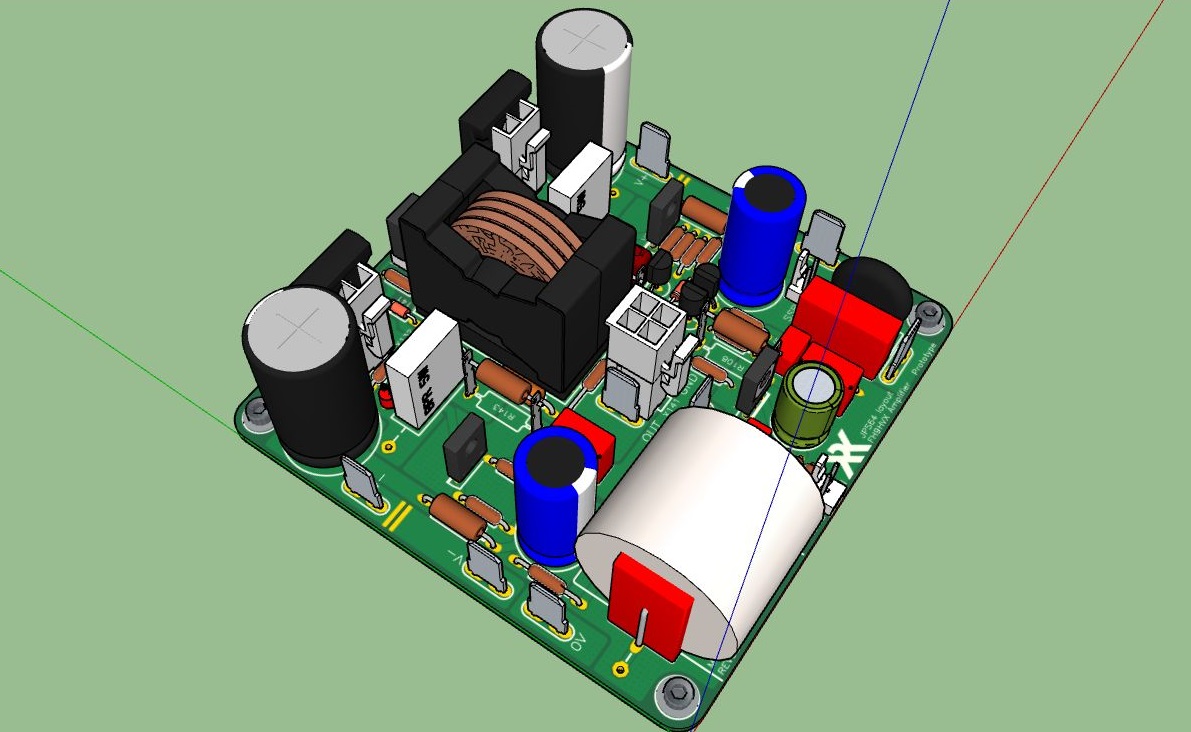
The KSC1845 for the LTP and KSC3503 for the LTP CCS, and KSA1381 and kSC3503 drivers are used in the FH9HVX and I also believe, contributes to the amp’s superb performance, beating the previous version FH9, which used BC546 and BD140/139.
I did some measurements earlier and found that carbon film feedback resistors have an impact on sound quality. There is higher second order harmonic distortion relative to third. A slight overall increase in THD but the third harmonic is less compared to metal thin film. On the same preamp, the metal thin film had higher third order relative to second order. This was on the Aksa Lender preamp. I even made series parallel arrays to reduce the thermal load. The effect was purely the material - carbon film vs metal thin film.
If you prefer a brighter sharper sound, metal thin film is fine. If you prefer a mellower slightly sweeter more natural sound, carbon film might sound good to you. Don’t use metal oxide thick film though. It increases overall THD significantly.
If you prefer a brighter sharper sound, metal thin film is fine. If you prefer a mellower slightly sweeter more natural sound, carbon film might sound good to you. Don’t use metal oxide thick film though. It increases overall THD significantly.
Last edited:
I did some measurements earlier and found that carbon film feedback resistors have an impact on sound quality. There is higher second order harmonic distortion relative to third.
You should repeat those measurements carefully, but include intermodulation as well, you'd normally expect carbon comp to be awful, carbon film poor, metal film by far and away the best (especially if generously rated for power). Even order products are not normally expected as voltage coefficient is symmetrical in most materials.
My memory was off. It was metal thick film that is to be avoided and both carbon film or metal thin film perform similarly well with regards to overall lower THD and lower third order vs second order harmonic distortion. Large 3w to 5w power resistors are often metal oxide, and these are the worst culprits when used as source resistors in the output stage of an amp. Recently I have found the best ones there are solid bulk metal (non inductive) resistors cut into the shape of a “U” or labyrinth ( I spiral). A great example are KOA BPR series. They out perform the baby blue colored Panasonic ERX’s.
Just my opinion, but I still find carbon thin film more natural sounding than metal thin film in the critical feedback resistor.
Just my opinion, but I still find carbon thin film more natural sounding than metal thin film in the critical feedback resistor.
Last edited:
Can anyone care to explain the difference between apex ax series, fx series, fh series, and studio reference? Following apex's thread left me confused since he has so many designs.
AX are BJT outputs, FX are lateral FET outputs, FH are hexfet outputs (I actually coined that name to distinguish it from FX), AA are Class A amps, reference amps are probably lower distortion designs vs most of his designs which are geared more for PA or consumer home use which is just average low or moderately low distortion. CA is a current feedback amp. PP is a preamp. The number after the letter refers to the number of actives on that design. There is an Apex Directory thread that shows the amps all in progressing level of complexity (monotonically increasing number of actives). You can get a sense of what is different.
A Directory of Apex Audio Amplifiers
A Directory of Apex Audio Amplifiers
Thin-film _is_ metal film.My memory was off. It was metal thick film that is to be avoided and both carbon film or metal thin film perform similarly well with regards to overall lower THD and lower third order vs second order harmonic distortion.
Thick-film is metal-oxide (ruthenium oxide in a sintered glass bead matrix typically).
You should usually see carbon being much the worst, if your measurements are done right, there's a lot of research showing this. Testing needs to be done at high voltages (20V swing or more) to properly exercise a feedback resistor in operation. Voltage coefficient shows up more at higher voltages and with physically smaller resistors. Having said that metal oxide are much more variable in quality it seems, so some examples may be particularly bad.
The subjective response to auditory input is strongly affected by other parts of the brain, which is why only double-blind testing can measure audio performance fairly. If you've not seen the McGurk effect before, check it out, it will starkly highlight the gullibility of human hearing to expectation. You hear what you want to hear, basically.Large 3w to 5w power resistors are often metal oxide, and these are the worst culprits when used as source resistors in the output stage of an amp. Recently I have found the best ones there are solid bulk metal (non inductive) resistors cut into the shape of a “U” or labyrinth ( I spiral). A great example are KOA BPR series. They out perform the baby blue colored Panasonic ERX’s.
Just my opinion, but I still find carbon thin film more natural sounding than metal thin film in the critical feedback resistor.
Basically metal film and wire-would measure to around 1ppm for voltage coefficient, around 100 times better than any carbon resistor. They are also lower noise and more stable.
- Home
- Amplifiers
- Solid State
- Apex Audio Recomendation
